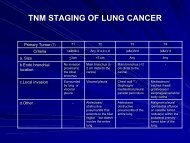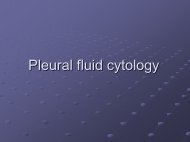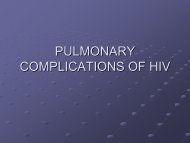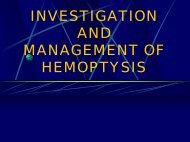New Modalities in TB Diagnosis - The Lung Center
New Modalities in TB Diagnosis - The Lung Center
New Modalities in TB Diagnosis - The Lung Center
Create successful ePaper yourself
Turn your PDF publications into a flip-book with our unique Google optimized e-Paper software.
• In India, out of a totalpopulation of over 1 billion,each year about 2 milliondevelop active disease and upto half a million die.*• It implies that every m<strong>in</strong>ute, adeath occurs due to <strong>TB</strong> <strong>in</strong> ourcountry.500,000*WHO/<strong>TB</strong>/97 1997;231: 9980<strong>TB</strong>MeaslesHIVTetanusSTDsTropical DiseasesMalaria
• Early diagnosis of <strong>TB</strong> and<strong>in</strong>itiat<strong>in</strong>g optimaltreatment would not onlyenable a cure of an<strong>in</strong>dividual patient but alsowill curb the transmissionof <strong>in</strong>fection and diseaseto others <strong>in</strong> thecommunity.**Indonesia10%Ch<strong>in</strong>a15%Bangladesh4%Russia1%India30%**Ind J Tub 1995; 42: 95South Africa2%Phillipp<strong>in</strong>es3%Pakistan4%Nigeria3%Othercoutries28%
• <strong>The</strong> diagnostic needs <strong>in</strong> disease non-endemic countries<strong>in</strong>clude:• Identification of latent <strong>in</strong>fection <strong>in</strong> high risk group.• <strong>Diagnosis</strong> of patients <strong>in</strong> early phase of disease.• Faster detection of outbreaks.• F<strong>in</strong>d<strong>in</strong>g out patients with non-tuberculousmycobacterial disease.
• <strong>The</strong> diagnostic needs <strong>in</strong> disease endemic countries <strong>in</strong>clude:• Improved microscopy.• Usage of liquid culture for childhood and extrapulmonary <strong>TB</strong>.• Chemical and physical detection of mycobacterialantigens <strong>in</strong> paucibacillary condition.• Antigen capture, Antibody detection and cellularimmune recognition.
• <strong>The</strong> diagnosis <strong>in</strong> endemic countries depends more onthe use of labour <strong>in</strong>tensive, easy to use methodologywith m<strong>in</strong>imum <strong>in</strong>frastructure or equipment.• <strong>The</strong> need is to f<strong>in</strong>d a viable alternative for smearmicroscopy.• This method has to have these desirable features :• Results with<strong>in</strong> 2 hours.• Simple tra<strong>in</strong><strong>in</strong>g.• Easy <strong>in</strong>terpretation.• Should function well <strong>in</strong> HIV +ve patients.• Should allow start of treatment as early as possible.
Methods<strong>TB</strong> <strong>Diagnosis</strong>Direct MethodsIndirect MethodsDetection of bacteria and its productsAntibodies aga<strong>in</strong>st mycobacteriaCT Scan and MRI Scan
Direct Methods• Direct Microscopy (ZN, K<strong>in</strong>youn, Flurochrome).• Culture (Traditional, Rapid methods).• Detection of DNA or RNA of mycobacterial orig<strong>in</strong>( PCR, LAMP, TAA / NAA, LCR, Fast Plaque).
Direct Microscopic Exam<strong>in</strong>ation• Hallmark of sta<strong>in</strong><strong>in</strong>g is Ziehl-Neelsen sta<strong>in</strong>ed slides.• Easiest & quickest diagnostic test.• Limited sensitivity (46-78%) but specificity is virtually 100%.• Centrifugation & flurochrome sta<strong>in</strong><strong>in</strong>g (auram<strong>in</strong>e O) with UVmicroscopy markedly <strong>in</strong>crease the sensitivity & a large number canbe exam<strong>in</strong>ed <strong>in</strong> a much shorter time.**Chest 1969;95:1193
Direct Microscopic Exam<strong>in</strong>ation• ZN sta<strong>in</strong><strong>in</strong>g requires = 10 5bacilli/ml.• <strong>TB</strong> bacilli appear asstraight/curved rods (1-4µ x0.2-0.8µ) s<strong>in</strong>gly, <strong>in</strong> pairs or <strong>in</strong>clumps.• <strong>The</strong> yield of microscopicexam<strong>in</strong>ation correlates wellwith the extent of disease, thepresence of cavitation, and thequality of specimen.• It is a good marker for<strong>in</strong>fectiousness & the responseto the treatment.
• Several approaches are be<strong>in</strong>g made to enhance thesensitivity of the smear microscopy :• Concentration of sputum sample by centrifugationenhances sensitivity to almost 100%.*• Treatment of sputum samples with Zwitterionicdetergent, also known as C 18carboxyprophylbeta<strong>in</strong>e(CB18)<strong>in</strong>terferes with the <strong>in</strong>natebuoyancy of the bacilli and enhances the result ofsputum microscopy.***J Cl<strong>in</strong> Microbiol 1999;31: 2371**J Cl<strong>in</strong> Microbiol 1998;36: 1965
Multiple sputum sampl<strong>in</strong>g100%80%60%40%FirstSecondThird20%0%Sputum Samples
Traditional Culture• More sensitive & can be positive even when bacterial load is low(10-100 bacilli/ml).• Sensitivity 80-85%; Specificity 98%.• Required for precise identification of causative organisms.• 3 Types of media are used:• Egg based: LJ, Petragnani and ATS.• Agar based: Middlebrook 7H10 or 7H11.• Liquid based: Kirschner’s, Middlebrook 7H9.• Growth is slow and takes 6-8 weeks . <strong>The</strong>re after the same length oftime is required for complete identification & sensitivity test<strong>in</strong>g.
Traditional Culture
Broth Based Rapid Culture Methods• Micro colony detection on solid media.• Radiometric (BACTEC).• Septicheck AFB.• Mycobacterial growth <strong>in</strong>dicator tubes (MGIT).• Substantial improvement <strong>in</strong> time to detection & totalnumber of positive cultures can be realized from us<strong>in</strong>gbroth based systems.
Micro colony Detection on Solid Media• Plates poured with th<strong>in</strong> layer of Middlebrook 7H11agar medium are <strong>in</strong>cubated and exam<strong>in</strong>edmicroscopically on alternate days for the first 2 daysand less frequently thereafter.• In less than 7 days micro-colonies of slow grow<strong>in</strong>gmycobacteria such as M.tb can be detected.
BACTEC• Radiometric method. (Cumm<strong>in</strong>gs 1975)• 4 ml of Middlebrook 7H12 broth conta<strong>in</strong><strong>in</strong>g carbon-14labeled palmitic acid is used.• 0.5 ml of processed specimen is added along with amixture of antibiotics to the broth.
BACTEC• Growth is ascerta<strong>in</strong>edby liberation of 14CO 2as metabolized bymycobacteria &detected by BACTEC460 <strong>in</strong>strument &reported <strong>in</strong> terms ofgrowth <strong>in</strong>dex (GI) value.
BACTEC• Average time to recovery of M.tb from smear positivespecimens is 8 days.• When smear negative, culture positive samples areexam<strong>in</strong>ed, mean time for detection is 14 days.• More sensitive than traditional method.*• Can also be used for drug susceptibility test<strong>in</strong>g.*J Cl<strong>in</strong> Microbiol 1994;32: 918-925
BACTEC• A special procedure unique to BACTEC system foridentification of M.tb complex is based on observationthat p-nitro-α-acetylam<strong>in</strong>o-β-hydroxypropiophenone(NAP) will <strong>in</strong>hibit organisms belong<strong>in</strong>g to M.tb complexwhile hav<strong>in</strong>g little or no effects on other mycobacteria.• Drawbacks :• Cost.• Problem of disposal of radioactive waste.
BACTECBACTEC 460 BACTEC 900MB
Septicheck AFB• Comb<strong>in</strong>es broth & solid media <strong>in</strong>to a s<strong>in</strong>gle device(biphasic culture approach).• Conta<strong>in</strong>s 30ml of modified Middlebrook 7H9 broth <strong>in</strong> CO 2enriched culture bottle & a peddle with agar media- oneside of peddle covered with Middlebrook 7H11; otherside conta<strong>in</strong>s Middle brook 7H11 with NAP.• Requires 3 weeks of <strong>in</strong>cubation• Advantage: Simultaneous detection of Mtb. NTM, otherrespiratory pathogen & even contam<strong>in</strong>ant.
Mycobacterial Growth Indicator Tube (MGIT)• Rapid Method.• Consists of round bottom tubes conta<strong>in</strong><strong>in</strong>g 4 ml ofmodified Middlebrook 7H9 broth which has an oxygensensitive fluroscent sensor at the bottom.*• When mycobacteria grow, they deplete the dissolvedoxygen <strong>in</strong> the broth & allow the <strong>in</strong>dicator to fluorescebrightly <strong>in</strong> a 365nm UV light.* J Cl<strong>in</strong> Microbiol 1999;37: 748-752
Mycobacterial Growth Indicator Tube (MGIT)Round bottom tubes
Mycobacterial Growth Indicator Tube (MGIT)• Positive signals are obta<strong>in</strong>ed <strong>in</strong> 10-12 days.• MGIT can also be used as a rapid method for thedetection of drug resistant stra<strong>in</strong>s of Mtb directly fromacid-fast smear positive samples as well as from <strong>in</strong>directdrug susceptibility studies.• Advantages over BACTEC• Cheaper.• No problem of radioactive waste disposal.J Cl<strong>in</strong> Microbiol 1999;37: 45-48
Detection and identification of mycobacteria directlyfrom cl<strong>in</strong>ical samples• Genotypic Methods :• PCR• LAMP• TMA / NAA• Ligase cha<strong>in</strong> reaction• Phenotypic Methods :• FAST Plaque <strong>TB</strong>
Polymerase Cha<strong>in</strong> Reaction (PCR)• Essentially PCR is a way to make millions of identicalcopies of a specific DNA sequence , which may be agene, or a part of a gene, or simply a stretch ofnucleotides with a known DNA sequence, thefunction of which may be unknown.• A specimen that may conta<strong>in</strong> the DNA sequence of<strong>in</strong>terest is heated to denature double stranded DNA.
Polymerase Cha<strong>in</strong> Reaction (PCR)• Specific synthetic oligonucleotide primers b<strong>in</strong>d to theunique DNA sequences of <strong>in</strong>terest and a heat stableDNA polymerase (<strong>The</strong>rmus aquaticus) extends theprimer to create a complete & complimentary strandof DNA.• This process is repeated sequentially 25-40 times,thereby creat<strong>in</strong>g millions of copies of targetsequence.
Polymerase Cha<strong>in</strong> Reaction (PCR)• <strong>The</strong> amplified sequencecan then be detected byagarose gelelectrophoresis.
Polymerase Cha<strong>in</strong> Reaction (PCR)• 65 Kd antigen (HSPs):• Used earlier• Heat shock prote<strong>in</strong> believed to be dist<strong>in</strong>ct fromother bacterial HSPs.• This gene is identical <strong>in</strong> all species ofmycobacteria.• <strong>The</strong>refore unsuitable for detect<strong>in</strong>g M.tb,particularly <strong>in</strong> areas where species like M.aviumor M.kansasii are prevalent.
Polymerase Cha<strong>in</strong> Reaction (PCR)• IS6110 :• It is a transposon which areself replicat<strong>in</strong>g stretches ofDNA.• Function not known.• This sequence has been found <strong>in</strong> the M.tb complexorganisms (M.tb, M.africanum, M.microti, M.bovis).• IS6110 sequence generally occurs only once <strong>in</strong> M.bovisbut is found as often as 20 times <strong>in</strong> certa<strong>in</strong> stra<strong>in</strong>s of M.tb,thus offer<strong>in</strong>g multiple targets for amplification.
Polymerase Cha<strong>in</strong> Reaction (PCR)• With recent modification PCR can detect even a fractionof a bacilli.• Role <strong>in</strong> pulmonary <strong>TB</strong> :• Detects nearly all smear +ve and culture +ve cases.• Useful technology for rapid diagnosis of smear –ve casesof active <strong>TB</strong>.• Able to identify 50-60% of smear -ve cases; this wouldreduce the need for more <strong>in</strong>vasive approaches to smear -ve cases.
• Dist<strong>in</strong>guish M.tb from NTM <strong>in</strong> smear +ve cases asIS6110 sequence is not found <strong>in</strong> NTM.*• Should not be used to replace sputummicroscopy.• Sensitivity, specificity, & PPV for PCR is 83.5%,99% & 94.2% respectively.***Am Rev Respir Dis 1991; 144:1160** J Cl<strong>in</strong> Microbiol 1999;31: 2049-2055
Polymerase Cha<strong>in</strong> Reaction (PCR)• Role <strong>in</strong> Extrapulmonary <strong>TB</strong>• Limited Role• No comprehensive large series compar<strong>in</strong>g theyield of PCR with other available approaches hasbeen published.• But at present, it is valuable adjunct <strong>in</strong> thediagnosis of <strong>TB</strong>M, pleurisy, pericardial <strong>TB</strong> & othercondition <strong>in</strong> which yield of other tests are low.
Polymerase Cha<strong>in</strong> Reaction (PCR)• Disadvantages :• Very high degree of quality control required.• Variation from lab to lab rema<strong>in</strong> significant.• In pts. on ATT, PCR should not be used as an<strong>in</strong>dicator of <strong>in</strong>fectivity as this assay rema<strong>in</strong>s +vefor a greater time than do cultures.*Am J Respir Crit Care Med 1997;155: 1804-1854
• High false +ve results <strong>in</strong> patients previouslytreated with ATT <strong>in</strong> contacts of sputum +ve activecases.• High Cost.• So, better understand<strong>in</strong>g of how to use thesetests <strong>in</strong> conjunction with available cl<strong>in</strong>ical<strong>in</strong>formation is essential.**Thorax 1992;47:690-694
LAMP*• Loop-mediated isothermal amplification.• It is a novel nucleic acid amplification method <strong>in</strong> whichreagents react under isothermal conditions with highspecificity, efficiency, and rapidity.• LAMP is used for detection of M.tb complex, M.avium,and M.<strong>in</strong>tracellulare directly from sputum specimens aswell as for detection of culture isolates grown <strong>in</strong> a liquidmedium (MGIT) or on a solid medium (Ogawa’smedium).*Iwamoto T et al J Cl<strong>in</strong> Microbiol 2003;41 :2616-2619
LAMP• This method employs a DNA polymerase and a set offour specially designed primers that recognize a total ofsix dist<strong>in</strong>ct sequences on the target DNA.• Species-specific primers were designed by target<strong>in</strong>g thegyrB gene.• Simple procedure, start<strong>in</strong>g with the mix<strong>in</strong>g of all reagents<strong>in</strong> a s<strong>in</strong>gle tube, followed by an isothermal reactiondur<strong>in</strong>g which the reaction mixture is held at 63°C.• 60-m<strong>in</strong> <strong>in</strong>cubation time.
LAMP• Due to its easy operation without sophisticatedequipment, it will be simple enough to use <strong>in</strong>:• Small-scale hospitals,• Primary care facilities• Cl<strong>in</strong>ical laboratories <strong>in</strong> develop<strong>in</strong>g countries.• Difficulties :• Sample preparation• Nucleic acid extraction• Cross-contam<strong>in</strong>ation.
TMA / NAA• Transcription Mediated Amplification (TMA).• Nucleic Acid Amplification (NAA).• <strong>The</strong>se techniques use chemical rather than biologicalamplification to produce nucleic acid.• Test results with<strong>in</strong> few hours.• Currently used only for respiratory specimens.
Ligase Cha<strong>in</strong> Reaction• It is a variant of PCR, <strong>in</strong> which a pair ofoligonucleotides are made to b<strong>in</strong>d to one of the DNAtarget strands, so that they are adjacent to eachother.• A second pair of oligonucleotides is designed tohybridize to the same regions on the complementaryDNA.
Ligase Cha<strong>in</strong> Reaction• <strong>The</strong> action of DNA polymerase and ligase <strong>in</strong> thepresence of nucleotides results <strong>in</strong> the gap betweenadjacent primers be<strong>in</strong>g filled with appropriatenucleotides and ligation of primers.• It is ma<strong>in</strong>ly be<strong>in</strong>g used for respiratory samples, andhas a high overall specificity and sensitivity for smear+ve and –ve specimens.
FAST Plaque <strong>TB</strong>• It is an orig<strong>in</strong>al phage based test.• It uses the mycobacteriophage to detect the presence ofM.tb directly from sputum specimens.• It is a rapid, manual test, easy to perform and has ahigher sensitivity than microscopy, <strong>in</strong> newly diagnosedsmear +ve pts.**Int J Tuberc <strong>Lung</strong> Dis 1998;2: 160
FAST Plaque <strong>TB</strong>
Indirect Methods• Antibody detection :• <strong>TB</strong> STAT-PAK• ELISA• India test <strong>TB</strong>• Antigen detection :• <strong>TB</strong> MPB 64 patch test.• Quantiferon-GOLD test.• Biochemical Assays :(ADA, Bromide Partition, GasChromatography).
Antibody Detection
<strong>TB</strong> STAT-PAK• Immuno-chromatographic test.• Has been evolved with a capability to differentiatebetween active or dormant <strong>TB</strong> <strong>in</strong>fection <strong>in</strong> whole blood,plasma or serum.• Its value <strong>in</strong> <strong>in</strong> disease endemic countries is yet to beascerta<strong>in</strong>ed.**Eur Resp J 1995;8: 676
Antibody detection by ELISA.• Several serodiagnostic tests, pr<strong>in</strong>cipally those us<strong>in</strong>gELISA methodology for measurement of IgG Ab areavailable.• 38-Kd Ag provides serodiagnostic test with mostfavorable test characteristics described, but is limited bythe lack of purified Ag.• Serum IgG Ab are observed to rise dur<strong>in</strong>g the first 3months of therapy but fall after 12-16 months.
Antibody detection by ELISA.• Other purified antigens to which antibodies are detected:• 30 Kd prote<strong>in</strong> antigen• 16 Kd heat-shock antigen• Lipoarab<strong>in</strong>omannan(LAM) – LAM is a complexglycolipid associated with cell wall of mycobacteria &is produced <strong>in</strong>substantial quantities by grow<strong>in</strong>gM.tb.• A60 antigen• ES31/41 antigen
Antibody detection by ELISA.• IgM Ab levels have usually been found to be so low thattheir reliable measurement has been difficult.• Serodiagnosis with crude Ag gives high false positiveresults.• <strong>The</strong>se tests lack specificity because polyclonal Ab areused.• Use of monoclonal antibodies have <strong>in</strong>creased theirspecificity.
Antibody detection by ELISA.• It takes several months after diagnosis for patients withpulmonary <strong>TB</strong> to reach maximum antibody titers so thatserodiagnosis appears to be more useful <strong>in</strong> chronicextrapulmonary disease (bone or jo<strong>in</strong>t) than <strong>in</strong> acuteforms (miliary, <strong>TB</strong>M).• Serodiagnosis also has limited utility <strong>in</strong> smear negativepatients with m<strong>in</strong>imal P<strong>TB</strong>; In pediatric <strong>TB</strong> & <strong>in</strong> diseaseendemic countries with high <strong>in</strong>fection rates.
Antibody detection by ELISA.• ELISA also has limited diagnostic potential <strong>in</strong> AIDSprevalent population.*• Tests are expensive, require tra<strong>in</strong>ed personnel &difficulty <strong>in</strong> dist<strong>in</strong>guish<strong>in</strong>g Mtb & NTM.• Serologic tests have not yet demonstrated sufficientperformance to warrant rout<strong>in</strong>e use <strong>in</strong> control programs.* Int J Tuberc <strong>Lung</strong> Dis 2000;4132: 5152-5388
Antibody detection by ELISA.• Sensitivity and specificity of ELISA serodiagnostic testsus<strong>in</strong>g measurement of serum IgG Ab to selectedmycobacterial Ag:Antigen Sensitivity Specificity38 Kd 49-89 98-10030 Kd 62-72 97-10016 Kd 24-71 97-99LAM 26-81 92-100A60 71-100 71-95
Antibody detection by ELISA.• <strong>The</strong> detection of mycobacterial antigens byimmunoassay <strong>in</strong> cl<strong>in</strong>ical specimens with high & variableprote<strong>in</strong> content is difficult.• Detection <strong>in</strong> sputum presents even greater cl<strong>in</strong>icalproblem because sputum is a non-homogenous gel .• False positive rates are high.• Abandonment of this diagnostic tool.
Insta test <strong>TB</strong>• It is a rapid <strong>in</strong> vitro assay for the detection of antibody <strong>in</strong>active <strong>TB</strong> disease us<strong>in</strong>g whole blood or serum.• <strong>The</strong> test employs an Ab b<strong>in</strong>d<strong>in</strong>g prote<strong>in</strong> conjugated to acolloidal gold particle and a unique comb<strong>in</strong>ation of <strong>TB</strong>Ags immobilized on the membrane.**Tuberc. <strong>Lung</strong> Dis 1998;2: 541
Antigen Detection
<strong>TB</strong> MPB 64 patch test• MPB 64 is a specific mycobacterial antigen for M.tbcomplex.• This test becomes +ve <strong>in</strong> 3-4 days after patch applicationand lasts for a week.• Specificity~100%, Sensitivity~98.1%.*• This promis<strong>in</strong>g test has been reported so far only <strong>in</strong> onesett<strong>in</strong>g <strong>in</strong> Philipp<strong>in</strong>es and needs to be carried out <strong>in</strong> othersett<strong>in</strong>gs.*Ind J Tuberc <strong>Lung</strong> Dis 1998;2: 541
Quantiferon-GOLD• Due to advances <strong>in</strong> molecular biology and genomics, analternative has emerged for the first time <strong>in</strong> the form of anew class of <strong>in</strong> vitro assays that measure <strong>in</strong>terferon(IFN-γ) released by sensitized T cells after stimulation byM. tuberculosis antigens.• Measures immune reactivity toM.tb.
Quantiferon-GOLD• Interferon-γ assays measure cell-mediated immunityby quantify<strong>in</strong>g IFN-γ released from sensitized T cells<strong>in</strong> whole blood/PBMCs <strong>in</strong>cubated with <strong>TB</strong> antigens.
• QuantiFERON-<strong>TB</strong> ® test (Cellestis, Australia– Commercially available.– Measures amount of IFN-γ produced. (ELISA)– FDA-approved for the detection of L<strong>TB</strong>I, 2001.• ELISPOT assay (Oxford, UK)– Similar to QFT.– Measures number of reactive lymphocytes.– Not commercially available.
Quantiferon-GOLD• Early assays employed PPD (same specificity problemsas the TST).• <strong>New</strong>er assays (e.g., QFT-Gold) employ <strong>TB</strong>-specificantigens: ESAT-6 and CFP-10.• Prote<strong>in</strong>s encoded with<strong>in</strong> the region of difference 1 ofM.tuberculosis.• Not shared with the BCG sub-stra<strong>in</strong>s and most NTM(except: M. kansasii, M. szulgai, M. mar<strong>in</strong>um and nonpathogenicM.bovis).
Quantiferon-GOLD• Improved specificity: able to dist<strong>in</strong>guish between <strong>TB</strong> andNTM, BCG <strong>in</strong>fection.• Studies <strong>in</strong> contacts, HIV <strong>in</strong>fected and children underway.• Recommended for use <strong>in</strong> “ALL circumstances <strong>in</strong> which thetubercul<strong>in</strong> sk<strong>in</strong> test is currently used”.*• Includes contact <strong>in</strong>vestigations, immigrant evaluation,surveillance (e.g. healthcare workers).*Mazurek et al MMWR 2005;54:15
IGRAs Vs. TST• TST• In vivo• S<strong>in</strong>gle antigen• Boost<strong>in</strong>g• 2 patient visits• Inter-reader variability• Results <strong>in</strong> 2-3 days• Read <strong>in</strong> 48-72 hrs• IGRAs• In vitro• Multiple antigens• No boost<strong>in</strong>g• 1 patient visit• M<strong>in</strong>imal <strong>in</strong>ter-readervariability• Results <strong>in</strong> 1 day• Stimulate w/i 12 hrs
IGRAs Vs. TST• QFT-g vs. TST Agreement = 83.6%*• Factors associated with discordance :–Prior BCG– Non-tuberculous mycobcateria immune reactivity– Site bias <strong>in</strong> read<strong>in</strong>g TST– <strong>TB</strong> Treatment*Mazurek et al JAMA 2001;286:1740
Biochemical markers of <strong>Diagnosis</strong>• Adenos<strong>in</strong>e deam<strong>in</strong>ase. (ADA)• Bromide partition test.• Gas chromatography of mycobacterial fatty acids(Tuberculostearic acid).
Adenos<strong>in</strong>e Deam<strong>in</strong>ase (ADA)• It is an enzyme of pur<strong>in</strong>e metabolism. <strong>The</strong> level of thisenzyme is 10 times higher <strong>in</strong> lymphocytes (T cells >Bcells) than <strong>in</strong> RBC.• Whenever there is cell mediated immune response to anantigenic stimuli, the ADA levels are the highest.• ADA is measured by the colorimetric method of Giusti.
• <strong>The</strong> enzymatic reaction is:Adenos<strong>in</strong>e + H 2 O + ADA = Inos<strong>in</strong>e + NH 3 +ADA• <strong>The</strong> amount of ammonia liberated is measured bythe colorimetric method.Cut-off Sensitivity SpecificityPleural Fluid 50 IU/ml 95% 100%Ascitic Fliud 32.3 IU/ml 89% 98%CSF 9 IU/ml 100% 100%
Bromide Partition Test• <strong>The</strong> partition of bromide ion between serum and CSFafter a load<strong>in</strong>g dose reflects the <strong>in</strong>tegrity of the bloodbra<strong>in</strong> barrier.• Either by direct chemical measurement or by us<strong>in</strong>g anisotopic tracer, the ratio of bromide <strong>in</strong> serum to that <strong>in</strong>CSF can be estimated.• Values
• In different studies the sensitivity and specificity of thistest has been found to be near 90%.*• It may be false +ve <strong>in</strong> herpes simplex, listeria, mumps,measles, pyogenic men<strong>in</strong>gitis and hypothyroidism.• With the availability of better tests, this test has beengiven up.*Taylor J et al. J Cl<strong>in</strong> Microbiol 1999; 34: 56-59
Tuberculostearic Acid (<strong>TB</strong>SA)• <strong>TB</strong>SA is found <strong>in</strong> the cell wall of mycobacterium.• It is identified by gas chromatography or massspectrophotometry.• It is a costly <strong>in</strong>vestigation and requires complexanalytical equipment. (Seldom used)• Sensitivity >95%,Specificity>99%.**French M et al. J Cl<strong>in</strong> Microbiol 1998; 54: 987-990
CT Scan and MRI Scan <strong>in</strong> the diagnosis of <strong>TB</strong>• <strong>The</strong> advent of CT and MRI imag<strong>in</strong>g <strong>in</strong> the last twodecades has redef<strong>in</strong>ed the approach <strong>in</strong> analysis ofvarious diseases <strong>in</strong>clud<strong>in</strong>g <strong>TB</strong>.*• CT and MRI have shown several advantages overconventional radiology <strong>in</strong> early diagnosis and follow-upof <strong>TB</strong> <strong>in</strong> different parts of the body.*Buxi <strong>TB</strong>S Indian J Pediatr 2002;69:965-972
• Pulmonary <strong>TB</strong> :• Lobar Pneumonia• CT is superior than pla<strong>in</strong> CXR <strong>in</strong> pick<strong>in</strong>g up theconsolidation, atelectasis and the hilar LN therebymak<strong>in</strong>g the diagnosis easy.• MRI reveals some of these changes, however, CT isthe diagnostic modality of choice <strong>in</strong> such cases.• Bronchopneumonia• On CT it is usually B/L and widespread, not alwayssymmetrical <strong>in</strong>volvement of lungs.
• Hilar and Mediast<strong>in</strong>al Lymphadenopathy• CT and MRI depict the hilar and mediast<strong>in</strong>al LNequally well.• Calcification <strong>in</strong> the nodes is however better seen onCT.• Necrosis is seen as focal areas of low attenuation ona CECT.• On MRI focal necrosis is seen as areas of <strong>in</strong>creasedsignal <strong>in</strong>tensity on T2W images.• EB<strong>TB</strong>• HRCT is sensitive <strong>in</strong> the detection of earlyendobronchial spread of disease.
CT Images of <strong>TB</strong> <strong>in</strong>different parts of the body.
• Miliary <strong>TB</strong>• Earliest form of miliary <strong>TB</strong> is detectable on HRCT.• Coalesc<strong>in</strong>g nodules result <strong>in</strong>to patchy irregularopacities and HRCT shows this variation effectivelyand has been described as “snowstorm appearance”.• HRCT shows cavitation, which is not evident on pla<strong>in</strong>CXR.• Pleural Effusion• CT is sensitive to diagnose and def<strong>in</strong>e even m<strong>in</strong>imalpleural effusion/pleural calcification.• Pleural fluid is seen on <strong>in</strong>version recovery MRimages as areas of <strong>in</strong>creased signal <strong>in</strong>tensity alongthe <strong>in</strong>ner aspects of the chest wall.
• Skeletal <strong>TB</strong>• Pott’s Disease (vertebral <strong>TB</strong>)• CT and MRI helps <strong>in</strong> demonstrat<strong>in</strong>g a small focus ofvertebral body <strong>in</strong>volvement and def<strong>in</strong><strong>in</strong>g the extent ofthe disease.• CT/MRI help to evaluate <strong>TB</strong> <strong>in</strong>volv<strong>in</strong>g the craniovertebraljunction, sacro-iliac jo<strong>in</strong>t and posteriorappendages.• <strong>The</strong>y are also helpful <strong>in</strong> assessment of sp<strong>in</strong>al canalencroachment , posterior element <strong>in</strong>volvement and <strong>in</strong>decid<strong>in</strong>g the surgical approach.
MRI Images of <strong>TB</strong> <strong>in</strong>different parts of the body.
• GIT <strong>TB</strong>• Strictures of the small bowel, mucosal edema andthicken<strong>in</strong>g are well visualized on CT.• MRI depicts the para-aortic, aortocaval andmesentric lymph nodes effectively.• GUT <strong>TB</strong>• Various patterns of hydronephrosis may be seenat MR urography.• MRI helps to differentiate macronodular <strong>TB</strong>lesions from the other mass lesions.
In the end…• Today, although many new techniques are available forthe diagnosis of <strong>TB</strong> and also for detection andidentification of M.tb, direct microscopy is the onlyfeasible method recommended for <strong>TB</strong> control program <strong>in</strong>India.• Most of the new techniques described <strong>in</strong>volve prohibitiveexpenditure, expertise & quality control, putt<strong>in</strong>g them outof reach of many labs <strong>in</strong> develop<strong>in</strong>g countries.
All the best..









